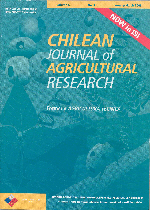
|
Agricultura Técnica
Instituto de Investigaciones Agropecuarias, INIA
ISSN: 0365-2807
EISSN: 0365-2807
Vol. 63, No. 1, 2003, pp. 69-80
|
 Bioline Code: at03009
Bioline Code: at03009
Full paper language: Spanish
Document type: Research Article
Document available free of charge
|
|
|
Agricultura Técnica, Vol. 63, No. 1, 2003, pp. 69-80
| es |
Evaluación de un Modelo Predictivo Sobre el Efecto de la Temperatura y Humedad en la Descomposición de Rastrojo de Trigo
Cortázar, Víctor García de G.; Silva, Paola C. & Acevedo, Edmundo H.
Resumen
Los objetivos de este trabajo fueron evaluar la descomposición de rastrojos de trigo (Triticum aestivum L.) bajo diferentes condiciones de temperatura y humedad en dos localidades, y comparar las mediciones efectuadas con las predicciones realizadas con el modelo de simulación de crecimiento de cultivos CropSyst. Se evaluó la tasa de descomposición de rastrojos de trigo dejados sobre la superficie del suelo, bajo tres dosis de paja (3; 6; y 9 t ha-1) y seis tratamientos de temperatura (definidos por el mes en que se colocaron los rastrojos en terreno) en dos experimentos de campo realizados en Santiago (Región Metropolitana) y El Carmen (VIII Región), Chile. El diseño fue de bloques completamente al azar con estructura factorial y cuatro repeticiones. En Santiago se agregó un tercer factor, nivel hídrico, con cuatro niveles definidos por alturas de agua aplicadas mediante aspersión. La tasa de descomposición se estimó mediante el método de la bolsa. Los mismos tratamientos se simularon en el modelo CropSyst y se compararon sus resultados con las mediciones experimentales. La temperatura tuvo un efecto significativo en la tasa de descomposición con incrementos de más del 200% entre los extremos. Los tratamientos hídricos no produjeron diferencias tan claras, aunque hubo tendencia a mayor descomposición con tratamientos hídricos altos. La comparación de los resultados experimentales con las simulaciones hechas con CropSyst, mostró sobreestimaciones y subestimaciones por parte del modelo dependiendo de la fecha. Las diferencias entre modelo y mediciones oscilaron entre 0 y 37% con promedio de 10%. Sin embargo, los valores de r2 fueron superiores a 0,92 y no hubo diferencias significativas con respecto a una pendiente ideal de 1.
Palabras-clave
temperatura, humedad, modelación, CropSyst, paja de trigo
|
| |
| en |
Evaluation of a Predictive Model of the Effect of Temperature and Humidity on Wheat Straw Decomposition
Cortázar, Víctor García de G.; Silva, Paola C. & Acevedo, Edmundo H.
Abstract
The objectives of this work were to evaluate wheat (Triticum aestivum L.) straw decomposition rates under different temperature and humidity levels in two locations, and to compare the actual measurements with predictions made with the crop growth simulator CropSyst. The decomposition rate was evaluated for three quantities of wheat straw (3; 6; and 9 t ha-1) left on the soil surface and six temperature treatments (defined by the month at which the straw was placed on the field) in two field experiments carried out in Santiago (Metropolitan Region) and El Carmen (VIII Region), Chile. The experimental design was randomized complete blocks in a factorial arrangement with four replicates. In Santiago a third factor was added, irrigation water, with four levels defined by water depth applied via sprinkler. The decomposition rate was measured by the bag method. The same experiments were simulated with CropSyst and the results were compared with the experimental values. Temperature had a significant effect on decomposition rate with increases of more than 200% between extreme temperatures. The water treatments did not produce clear differences, even though there was a tendency to greater decomposition with higher water applications. The comparison of the experimental results with the simulations made with CropSyst, showed over- and under-estimations on the part of the model depending on the date. The differences between the model and field data varied between 0 and 37% with an average of 10%. However, r2 values were over 0.92 and there were no significant differences with respect to an ideal slope of 1.
Keywords
temperature, humidity, modeling, CropSyst, wheat straw
|
| |
© Copyright 2003 - Instituto de Investigaciones Agropecuarias, INIA (Chile)
Alternative site location: http://www.inia.cl/at/agritec.htm
|
|
